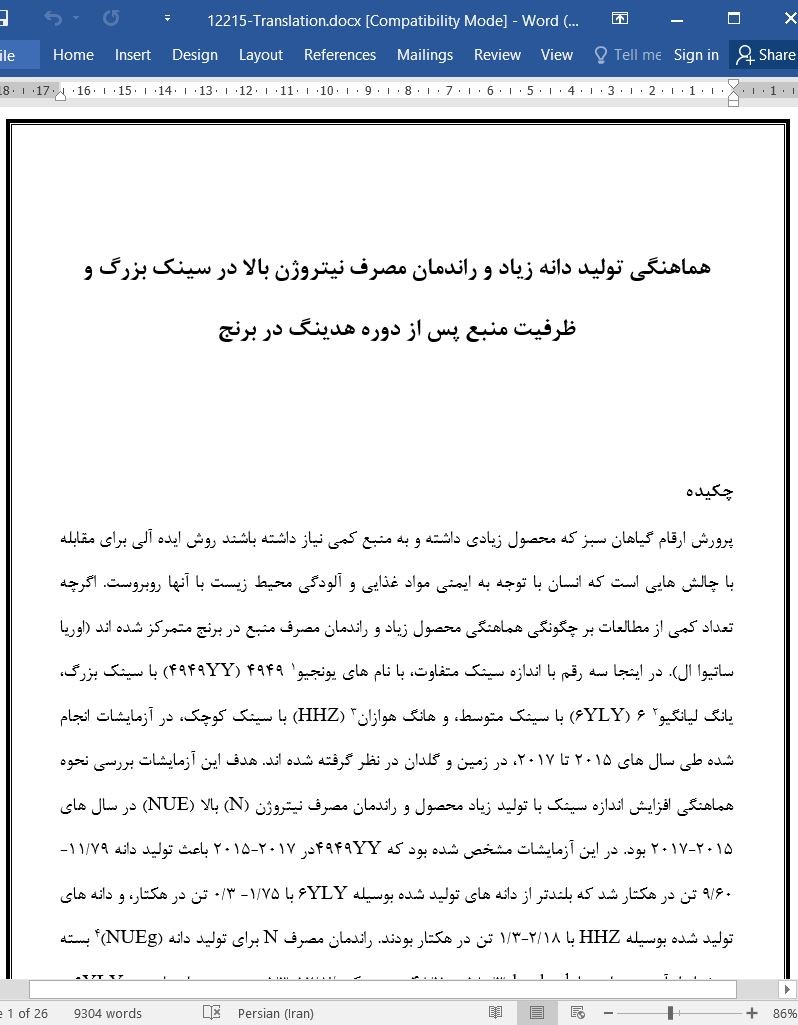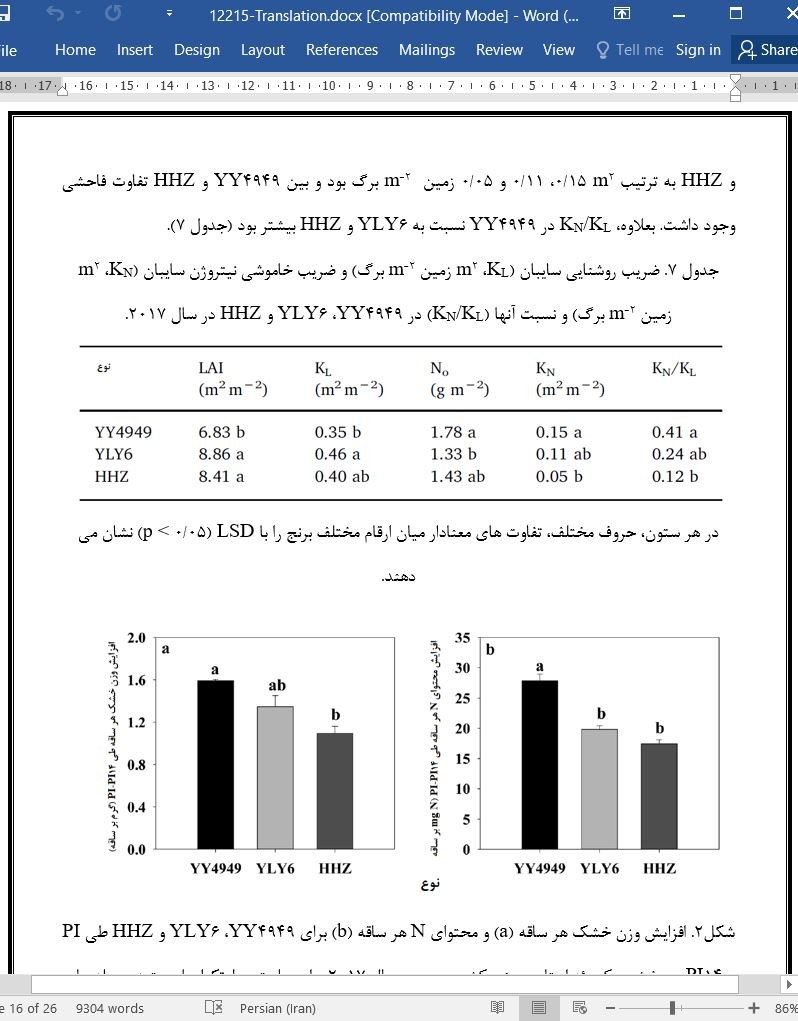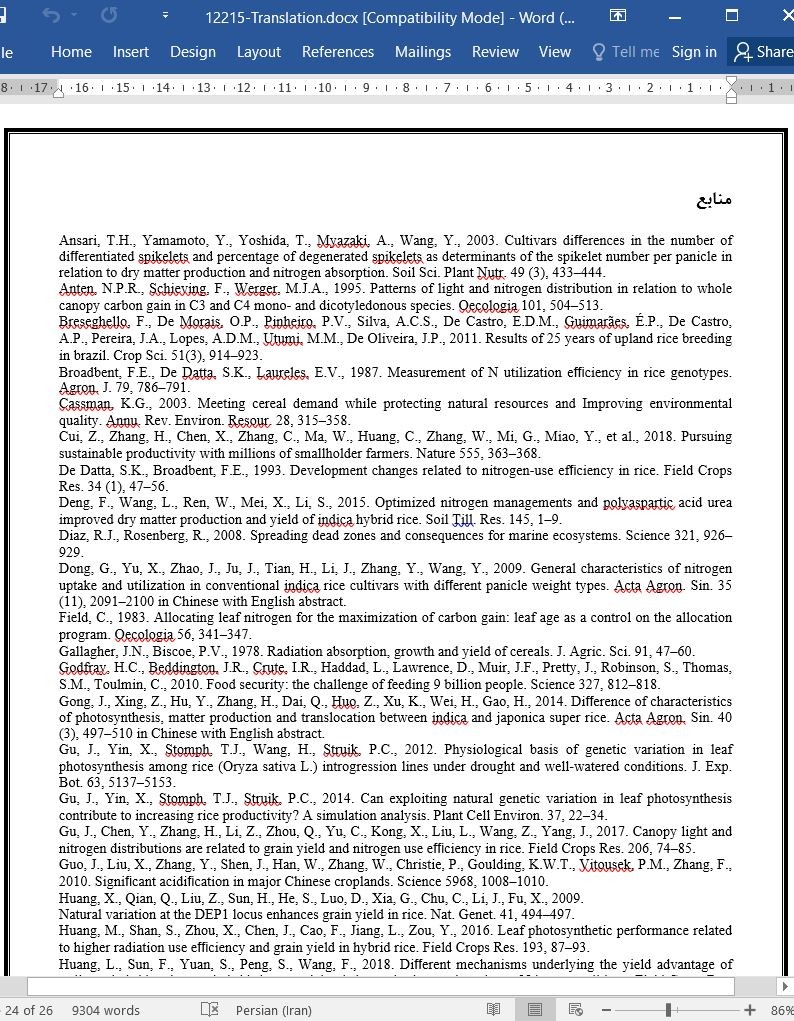
هماهنگی تولید دانه زیاد و راندمان مصرف نیتروژن بالا در سینک بزرگ و ظرفیت منبع
چکیده
پرورش ارقام گیاهان سبز که محصول زیادی داشته و به منبع کمی نیاز داشته باشند روش ایده آلی برای مقابله با چالش هایی است که انسان با توجه به ایمنی مواد غذایی و آلودگی محیط زیست با آنها روبروست. اگرچه تعداد کمی از مطالعات بر چگونگی هماهنگی محصول زیاد و راندمان مصرف منبع در برنج متمرکز شده اند (اوریا ساتیوا ال). در اینجا سه رقم با اندازه سینک متفاوت، با نام های یونجیو 4949 (4949YY) با سینک بزرگ، یانگ لیانگیو 6 (6YLY) با سینک متوسط، و هانگ هوازان (HHZ) با سینک کوچک، در آزمایشات انجام شده طی سال های 2015 تا 2017، در زمین و گلدان در نظر گرفته شده اند. هدف این آزمایشات بررسی نحوه هماهنگی افزایش اندازه سینک با تولید زیاد محصول و راندمان مصرف نیتروژن (N) بالا (NUE) در سال های 2017-2015 بود. در این آزمایشات مشخص شده بود که 4949YYدر 2017-2015 باعث تولید دانه 79/11-60/9 تن در هکتار شد که بلندتر از دانه های تولید شده بوسیله 6YLY با 75/1- 3/0 تن در هکتار، و دانه های تولید شده بوسیله HHZ با 18/2-3/1 تن در هکتار بودند. راندمان مصرف N برای تولید دانه (NUEg) بسته به شرایط آب و هوایی با kg kg-1 3/ 58 - 7/48 رسید، که %8/12-3/5 نسبت به راندمان در 6YLY و %7/20-8/15 نسبت به راندمان در HHZ بیشتر بود.تولید دانه های بلندتر و NUEg برای 4949YY ناشی از: (1) راندمان بالاتر تولید سنبله نسبت به ماده خشک، N، دمای تجمع یافته و تابش؛ (2) تولید بیوماس بیشتر و تجمع N پس از گل دهی؛ (3) RUE بالاتر پس از گل دهی به دلیل ساختار سایبان بهتر بود. در نتیجه، برای تولید برنج در آینده باید اندازه سینک را بویژه از طریق اصلاح راندمان تولید اندازه سینک افزایش داد، و در عین حال ظرفیت تولید بیوماس پست هدینگ را بالاتر ببرد.
مقدمه
جمعیت جهانی با نرخ رشد کنونی خود، قرار است تا سال 2050 تقریبا به 10 بیلیون نفر برسد (سازمان ملل، 2017). افزایش تولید محصولات زراعی برای حفظ ایمنی غذایی، ضمن کاهش اثرات زیست محیطی کشاورزی، چالش دوگانه ای است که انسان در آینده با آنها روبرو خواهد بود (کاسمن، 2003؛ کوی و همکاران، 2018). بعلاوه این هدف باید تحت شرایط تغییرات آب و هوایی محقق شود (پنگ و همکاران، 2004). بنابراین هدف سنتی به دنبال تولید فوق العاده زیاد محصول بودن با هدف دستیابی به محصول زیاد، کیفیت عالی، راندمان بالا، سازگار با محیط زیست، و ایمنی مواد غذایی بطور همزمان در آغاز قرن 21، جایگزین شده است (کاسمن، 2003؛ ژانگ، 2007).
4. بحث
دانشمندان به علت پیچیدگی و زمانبر بودن اندازه گیری پارامترهای NUE، همیشه تلاش می کنند تا ویژگی های زراعی و فیزیولوژیکی را که می توان به عنوان جایگزین NUE بکار برد، شناسایی کنند (برادبنت و همکاران، 1987؛ دِ داتا و برادبنت، 1993؛ سینگ و همکاران، 1998؛ کوتروباس و تانوس، 2003؛ وو و همکاران، 2016). متاسفانه تا به حال چنین پارامترهایی نتوانسته اند نیازهای تولید کنندگان را برآورده کنند. بر اساس یافته های اولیه مان ک تولید دانه، NUE، و اندازه سینک بطور پیوسته تنها با اصلاح ژنتیک برنج در چین (زو و همکاران، 2016)، و ارتباط ژنتیکی بین اندازه خوشه و NUE (هانگ و همکاران، 2009) افزایش یافتند، تحقیق حاضر مکانیسم های فیزیولوژیکی اساسی ارتباط تولید دانه زیاد و NUE بالا را بوسیله اندازه سینک بزرگ بویژه در هنگام تزریق N کاهش یافته، نشان داد. تفاوت در اندازه سینک در میان سه نوع مختلف برنج به شرایط آب و هوایی هر سال بستگی داشت که با تفاوت NUEg میان ارقام مختلف سازگار بود. در کل، سینک بزرگ برای نوع 4949YY بطور قابل توجهی تولید دانه و راندمان مصرف N (NUEg) بیشتری داشت، بویژه وقتی که دما در مرحله هدینگ بالا نبود. سه دلیل فیزیولوژیکی برای تولید دانه بیشتر و NUEg بالاتر در 4949YY وجود داشت: (1) راندمان بالاتر تولید سنبله در رابطه با ماده خشک، N، دما و تابش انباشت؛ (2) تولید بیوماس بالاتر و تجمع N بعد از گل دهی؛ (3) RUE بالاتر بعد از گل دهی به علت ساختار مناسب سایبان.
Abstract
Breeding green varieties that have high yield potential and require less resource input is the ideal way to cope with the challenges that human is facing with respect to food security and environmental pollution. However, few studies have focused on how high yield and high resource use efficiency is coordinated in rice (Oryza sativa L.). Here three varieties with different sink size, namely Yongyou4949 (YY4949) with large sink size, Yangliangyou6 (YLY6) with medium sink size, and Huanghuazhan (HHZ) with small sink size, were used in field and pot experiments in 2015–2017. The objective was to examine how enlarged sink size coordinate high yield and high nitrogen (N) use efficiency (NUE). It was found that YY4949 produced a grain yield of 9.60-11.79 t ha−1 in 2015–2017, which was higher than that of YLY6 by 0.3-1.75 t ha−1, and that of HHZ by 1.3-2.18 t ha−1. N use efficiency for grain production (NUEg) of YY4949 reached 47.7-58.3 kg kg−1 depending on the weather condition, which was 5.3–12.8% higher than that of YLY6 and 15.8–20.7% higher than that of HHZ. The concomitantly higher grain yield and NUEg of YY4949 were due to: (1) higher efficiency of spikelet production in respect of dry matter, N, accumulated temperature and radiation; (2) higher biomass production and N accumulation after flowering; (3) higher RUE after flowering due to the better canopy structure. In conclusion, rice breeding in the future should continue to enlarge the sink size especially through the improvement in production efficiency of sink size, while simultaneously increase the post-heading biomass production capacity.
1. Introduction
At its current rate of growth, the global population is set to reach ˜10 billion people by 2050 (UN, 2017). Increasing crop production to maintain food security while reducing agriculture’s environmental impacts is the dual challenges that human is facing in the future (Cassman, 2003; Cui et al., 2018). Moreover, this objective has to be realized under the condition of changing climate (Peng et al., 2004). Hence the traditional goal of pursuing super-high yield has been replaced by achieving high yield, high quality, high efficiency, environmentfriendly, and food safety simultaneously at the beginning of 21st century (Cassman, 2003; Zhang, 2007).
4. Discussion
Due to the measurement of NUE parameters is complex and timeconsuming, scientists are always trying to identify the readily measured agronomic or physiological traits that can be used as a proxy of NUE (Broadbent et al., 1987; de Datta and Broadbent, 1993; Singh et al., 1998; Koutroubas and Ntanos, 2003; Wu et al., 2016). Unfortunately, until now no such parameters could satisfy breeders’ requirement. Based on our previous finding that grain yield, NUE, and sink size were concomitantly increased along with the rice genetic improvement in China (Zhu et al., 2016) and the genetic linking between panicle size and NUE (Huang et al., 2009; Hu et al., 2014), the present study examined the physiological mechanisms underlying the coordination of high grain yield and high NUE by large sink size especially at reduced N input condition. Difference in sink size among the three varieties varied depending on the weather condition in each year, which was consistent with difference in NUEg among the three varieties. In general, the large sink size variety YY4949 had significantly higher grain yield and N utilization efficiency (namely NUEg) especially when no high temperature occurred at heading stage. There were three physiological causes for the higher grain yield and higher NUEg of YY4949: (1) higher efficiency of spikelet production in respect of dry matter, N, accumulated temperature and radiation; (2) higher biomass production and N accumulation after flowering; (3) higher RUE after flowering due to the better canopy structure
چکیده
مقدمه
2. مواد و روش ها
1.2. مواد گیاه
2.1.1. طراحی و سایت آزمایش
2.2. نمونه برداری و اندازه گیری ها
2.2.1. تحلیل آماری
3. نتایج
3.1. شرایط آب و هوایی
3.2. تولید دانه، مولفه های تولید و شاخص برداشت (HI)
3.3. مصرف و جذب N گیاه
3.4. تباهی و جدا شدن سنبله
3.5. تجمع ماده خشک و پارامترهای مربوطه
3.5.1. مدت رشد و تجمع ماده خشک
3.5.2. سایبان حائل پرتوهای تابشی و RUE
3.5.3. توزیع N و نور با سایبان
3.5.4. نیتروژن برگ خاص (SLN)
3.5.5. نرخ کاهش LAI و بقای سطح برگ (LAD)
3.6. نسبت سنبله ها به سطح برگ در مرحله هدینگ
3.7. ارتباط تولید دانه و NUEg با تجمع N (دانهTN)، غلظت N دانه (دانهN) و غلظت N برگ (برگN) در مرحله PM
4. بحث
منابع
ABSTRACT
1. Introduction
2. Materials and methods
2.1. Plant materials
2.1.1. Experiment site and design
2.2. Sampling and measurements
2.2.1. Statistical analysis
3. Results
3.1. Whether condition
3.2. Grain yield, yield components and harvest index (HI)
3.3. Plant N uptake and utilization
3.4. Spikelet differentiation and degeneration
3.5. Dry matter accumulation and the related parameters
3.5.1. Growth duration and dry matter accumulation
3.5.2. Canopy intercepted radiation and RUE
3.5.3. Light and N distributions with the canopy
3.5.4. Specific leaf nitrogen (SLN)
3.5.5. Rate of LAI decrease and leaf area duration (LAD)
3.6. Spikelets to leaf-area ratio in the heading stage
3.7. Correlations of grain yield and NUEg with grain N accumulation (TNgrain), grain N concentration (Ngrain) and leaf N concentration (Nleaf) at PM
4. Discussion
References
- اصل مقاله انگلیسی با فرمت ورد (word) با قابلیت ویرایش
- ترجمه فارسی مقاله با فرمت ورد (word) با قابلیت ویرایش، بدون آرم سایت ای ترجمه
- ترجمه فارسی مقاله با فرمت pdf، بدون آرم سایت ای ترجمه



